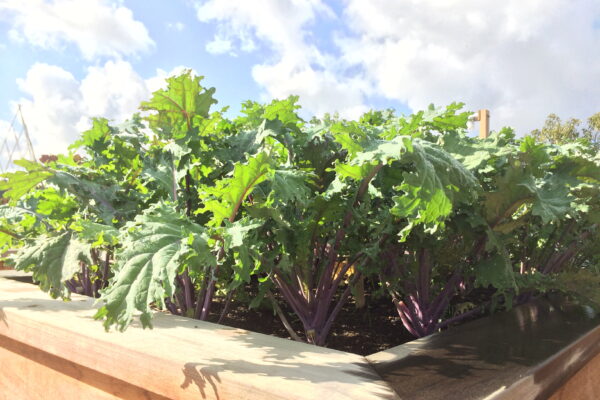Play
The World of Kale
Thanks to everyone who came to last weekend’s DIG IT class: Explore the World of Kale! We had a nice turnout and we discussed everything from how to grow kale and common pest problems to the health benefits of this so-called “super-food” and how to use it in the kitchen. If you missed the class, don’t worry, we’ve got you covered! Read on for more information on kale varieties, recipes, and the health benefits of this cold hardy plant that thrives during our mild Bay Area winters.
Super Food!
You may have heard kale described as a “super-food” and wondered what could possibly make a food “super.” Simply put, kale is chock full of important nutrients. One cup alone has over 125% of your daily intake of vitamin C, over 600% vitamin K, and over 200% vitamin A, plus impressively high amounts of calcium, iron, fiber, and protein. What’s more, kale’s unique leaf pigments and cell structure are rich in antioxidants and anti-inflammatory nutrients, which some studies have linked to fighting cancer and other diseases. Impressive stuff! With that said, remember that like all good things, kale should be eaten in moderation – there’s no need to overdo it!
Kale Varieties
Don’t forget that kale comes in many different shapes, sizes, and colors. They’re all delicious and beautiful in their own way, but if you’re new to kale, we recommend Tuscan or “dinosaur” kale (pictured above) to get your feet wet – it’s known to be the sweetest and least bitter of the kale varieties. Keep your eye out at your local nursery, however, for the frilly purple-stemmed Red Russian, the compact curly leaf Blue Curled Scotch (perfect for those of you with limited growing space), or the purple curly leaf Scarlet kale (picture below) that adds a great splash of bright color in your winter garden, as well as being an ideal variety for delicious, salty kale chips! Don’t worry either if you live somewhere in the Bay Area where temperatures drop below freezing at night – kale harvested after the winter’s first frost is noticeably sweeter.
Kale Recipes
When it comes to using kale in the kitchen, don’t limit yourself! There’s more you can do with this versatile leafy green than first meets the eye. Below are some ideas to get you going:
- Kale Pesto – The key is walnuts instead of pine nuts. Trust us.
- Kale Chips – We highly recommend using a curly leaf variety for chips, but dinosaur kale works, too.
- Kale Smoothie – If you have friends or family who for some crazy reason can’t stomach the taste of kale, there’s always kale smoothies! Packs all the health benefits without the leafy green taste.
- Raw Kale Salad – If you want to eat your kale raw, remember to pick your leaves before they grow too big. They’ll be much more tender that way, plus as weird as it sounds, “massaging” your kale is important!
- Sauteed Kale – Sometimes keeping it simple is best! Delicious served warm with a runny egg on top.
No matter who you are and what your taste may be, we promise that you can find a kale variety and recipe that’s perfect for you. Happy gardening and happy eating, and be sure to join us for December’s DIG IT class – Cocktails from the Garden! Back by popular demand, we’ll be talking about teas and cocktails that you can make from easy-to-grow ingredients found in the garden.
PHOTO CREDITS: HOMESTEAD DESIGN COLLECTIVE



